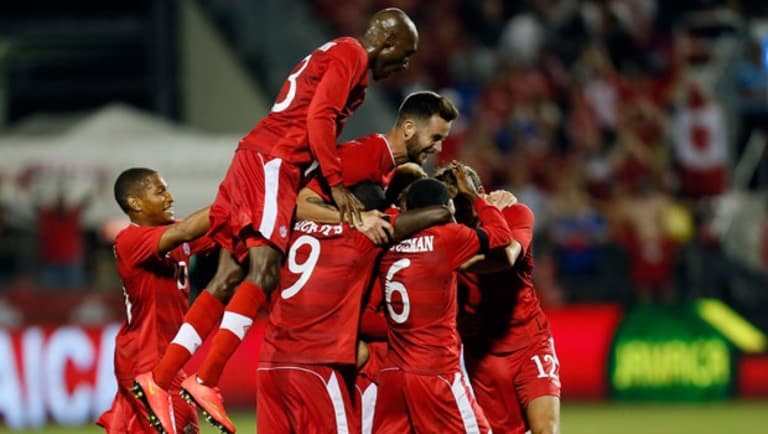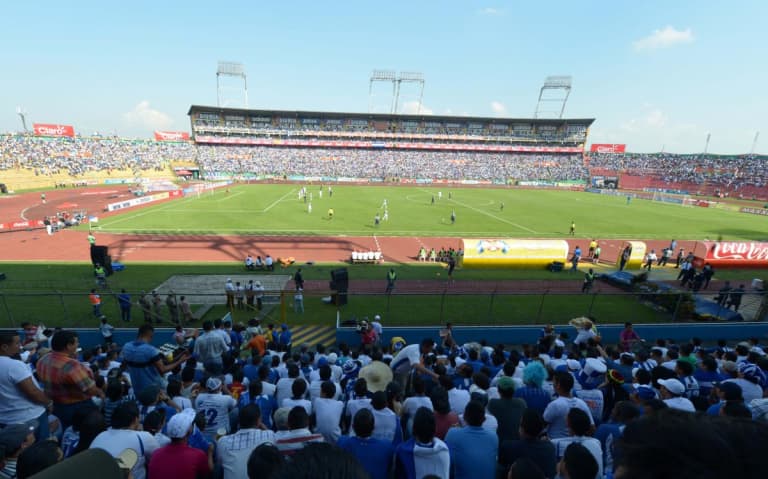Exactly 30 years ago, on Sept. 14, 1985, the Canadian men’s national team experienced one of its highest highs, qualifying for the FIFA World Cup for the first (and thus far, only) time.
Slightly less than three years ago, the team endured one of its lowest lows, tumbling out of World Cup qualifying with a thoroughly humiliating 8-1 defeat.
In both instances, the nation on the other side of the field was Honduras.
The Central American country of about 8 million people has played an outsized role in Canada’s World Cup quests over the last three decades. It shall be again on the road to Russia for the 2018 World Cup, as Canada Soccer announced on Monday afternoon that Les Rouges will begin play in the semifinal round of qualifying on Nov. 13 in Vancouver against, you guessed it, Honduras.
The game at BC Place will be the first opportunity in a decade for fans in Vancouver to see the men’s national team play in their backyard, as well as a chance for Canada to avenge the aforementioned 8-1 disaster from October 2012.
While November’s game will surely be well received by fans on the west coast – already riding a soccer-related high this year, with the Women’s World Cup and a terrific season by the Vancouver Whitecaps – the choice of locale for this massive World Cup qualifier has caused some consternation elsewhere in Canada.

Some would have preferred an outdoor locale (such as Edmonton or Ottawa), where chilly autumn temperatures might have given the home side an advantage. After all, when Canada head down to San Pedro Sula, the Hondurans often put the game at midday to ratchet up the heat. Should Canada be similarly strategic with its home legs?
Interestingly, that decisive game back on Sept. 14, 1985, was not played in one of Canada’s major urban centers. It was held in front of a raucous, pro-Canada crowd at King George V Park in St. John’s, Newfoundland.
There’s an apocryphal tale about a collection of Honduran fans who missed out on the game because they mistakenly went to St. John, New Brunswick instead. However true it may be, the home fans who did make the game were delighted by a 2-1 victory that sent Canada to Mexico 1986.
It’s impossible to quantify the impact of the crowd, the venue or the weather on that day’s outcome. The only certainty is that in a do-or-die competitive scenario against Honduras, the Canadian team stepped up and won.
The team did it again in qualifying for the 1994 World Cup, beating Honduras 3-1 at Swangard Stadium in Burnaby (just outside Vancouver) on April 18, 1993.
But those glorious days would prove to be outliers, rather than the start of a trend. Something changed in the run-up to the 2006 competition—Honduras, perhaps in delayed revenge for 1985, became the bane of Canada’s soccer existence.
The two teams were drawn together in the semifinal round of qualifying ahead of Germany 2006, with their first meeting coming on Sept. 4, 2004, at Commonwealth Stadium in Edmonton. An 82nd-minute goal by Jason de Vos looked to be enough to give the home side the victory.

But six minutes later, referee Benito Archundia (
, pictured at right) was deceived by a bit of, ahem, “gamesmanship” in the Canadian penalty area. Amado Guevara converted the penalty, and the game ended 1-1.
A month later in San Pedro Sula, a 73rd-minute goal from a 21-year-old Atiba Hutchinson again put Canada ahead. But amidst stifling conditions, Canada conceded an equalizer in second-half stoppage time; though the draw did not mathematically eliminate Canada, it was the spiritual end of their campaign.
Four years later, the sides were once again drawn together in the semifinal round. This time, the scene of their first clash was Stade Saputo in Montreal, on Sept. 6, 2008.
A fourth-minute goal by Adrian Serioux sent the Canadian fans (strongly outnumbered by Honduran supporters on the day) into delirium, but it would be short-lived. Top striker Tomasz Radzinski suffered a freak hand injury late in the first half after sliding into the advertising boards and had to leave the game.
Honduras scored two quick goals in the second half, before a foul (term used loosely) on Guevara resulted in a second yellow for Patrice Bernier, neutering Canada’s chances of a comeback. The 2-1 loss left Canada with just one point from its first two games; a 3-1 defeat in San Pedro Sula a month later would officially end Canada’s attempts to reach South Africa 2010.
In the run-up to Brazil 2014, Canada and Honduras once again met in the semifinal round. Toronto’s BMO Field served as the backdrop for their first showdown of the cycle – but for the third straight time, Les Rouges couldn’t capitalize on their home-field advantage, scraping out just a 0-0 draw.

Then, needing just a single point in the final game of the group stage to reach the Hex, Canada went down to San Pedro Sula (Estadio Olimpico pictured at right) and … well, we all know how that ended.
So here we are again. With another San Pedro Sula showdown looming in September 2016, Canadian fans will be hoping that the match in Vancouver can give their team something they haven’t gotten in more than 20 years—three points against Honduras in World Cup qualifying.
While neither Honduras nor Canada are among the favorites to make it to Russia 2018, both will feel they have a shot at emerging from what should be a hotly-contested group that also includes Mexico and El Salvador.
The Canadians know, particularly given their history with Honduras, they cannot afford to settle for anything less than a win on Nov. 13.
If Canada leave BC Place with three points, any skepticism about venue selection will surely be cast aside and the team, ideally, can turn the page on what’s been a rather frustrating recent relationship with the Honduran team.
But if, for the fourth straight cycle, Canada see their World Cup dreams dashed by an inability to defeat Honduras? Well then, the soccer gods are making themselves crystal clear.
Next time, we’re going back to St. John’s.






